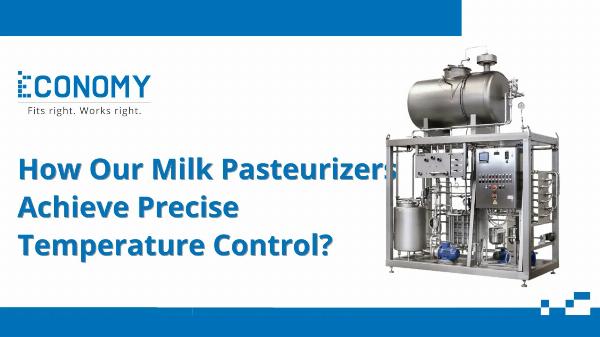How Our Milk Pasteurizers Achieve Precise Temperature Control

Milk pasteurization is a critical process in the dairy industry, ensuring that milk is safe for consumption by eliminating harmful pathogens without compromising nutritional quality. Precise temperature control is the cornerstone of effective pasteurization, and our advanced milk pasteurizers are designed to achieve this with exceptional accuracy. This article delves into the technology and methods that enable our milk pasteurizers to maintain precise temperature control, ensuring the highest standards of safety and quality.
The Importance of Temperature Control in Milk Pasteurization
Pasteurization involves heating milk to a specific temperature for a set period to kill bacteria, yeasts, and molds that can cause spoilage and disease. The most common methods include High-Temperature Short Time (HTST) pasteurization, which heats milk to 72°C (161°F) for 15 seconds, and Ultra-High Temperature (UHT) pasteurization, which heats milk to 135°C (275°F) for a few seconds. Both methods require precise temperature control to be effective without affecting the milk's flavor, texture, or nutritional value.
Advanced Heating Technologies
Our milk pasteurizers employ state-of-the-art heating technologies to ensure accurate temperature control. These include:
Plate Heat Exchangers (PHEs):
PHEs are widely used in HTST pasteurizers. They consist of multiple thin, corrugated plates that create channels for milk and heating medium (usually hot water or steam) to flow in alternating directions. The large surface area of the plates facilitates rapid and uniform heat transfer, allowing precise control of the milk's temperature. The design also ensures that the milk is heated evenly, preventing hotspots that could lead to over- or under-pasteurization.
Tubular Heat Exchangers:
Used in UHT pasteurization, tubular heat exchangers consist of concentric tubes where milk flows through the inner tube while the heating medium circulates in the outer tube. This configuration allows for efficient heat transfer and precise temperature control, essential for the higher temperatures required in UHT processing. The robust design of tubular heat exchangers also makes them suitable for handling higher pressures and flow rates.
Precise Temperature Monitoring and Control Systems
Our pasteurizers are equipped with advanced temperature monitoring and control systems that ensure consistent and accurate temperature regulation throughout the pasteurization process. Key components include:
Digital Temperature Sensors:
High-precision digital sensors continuously monitor the temperature of the milk at various stages of the process. These sensors provide real-time data, allowing for immediate adjustments to maintain the desired temperature range. The use of digital sensors ensures accuracy and reliability, crucial for meeting stringent safety standards.
Programmable Logic Controllers (PLCs):
PLCs are central to the automation of our pasteurization systems. They receive data from the temperature sensors and use sophisticated algorithms to control the heating elements and flow rates. This ensures that the milk is heated to the exact temperature required for pasteurization and held at that temperature for the specified duration. PLCs also facilitate the seamless integration of various components, enabling precise coordination and control.
Feedback Control Loops:
Our pasteurizers utilize feedback control loops to maintain temperature stability. In a feedback loop, the actual temperature is continuously compared to the setpoint temperature. Any deviation triggers corrective actions, such as adjusting the flow rate of the heating medium or modulating the power to heating elements. This dynamic control mechanism ensures that the pasteurization process remains within the desired temperature range, even in the face of fluctuations in milk flow rate or incoming milk temperature.
Benefits of Precise Temperature Control
Achieving precise temperature control in milk pasteurization solutions offers several significant benefits:
Enhanced Safety:
Accurate temperature control ensures the effective elimination of harmful microorganisms, safeguarding public health and preventing foodborne illnesses.
Consistent Product Quality:
Maintaining the optimal temperature range preserves the sensory and nutritional qualities of the milk, delivering a product that meets consumer expectations for taste, texture, and nutritional value.
Extended Shelf Life:
Effective pasteurization extends the shelf life of milk by reducing spoilage, allowing for longer storage and reducing food waste.
Regulatory Compliance:
Adhering to precise temperature control ensures compliance with food safety regulations and standards, protecting brands from legal and reputational risks.
Conclusion
Our milk pasteurizers are engineered to achieve precise temperature control through advanced heating technologies, sophisticated monitoring systems, and dynamic control mechanisms. This ensures the highest levels of safety, quality, and efficiency in milk pasteurization, meeting the stringent demands of the dairy industry. By prioritizing precision and reliability, we provide pasteurization solutions that not only protect public health but also enhance the value and appeal of dairy products.
Note: IndiBlogHub features both user-submitted and editorial content. We do not verify third-party contributions. Read our Disclaimer and Privacy Policyfor details.


